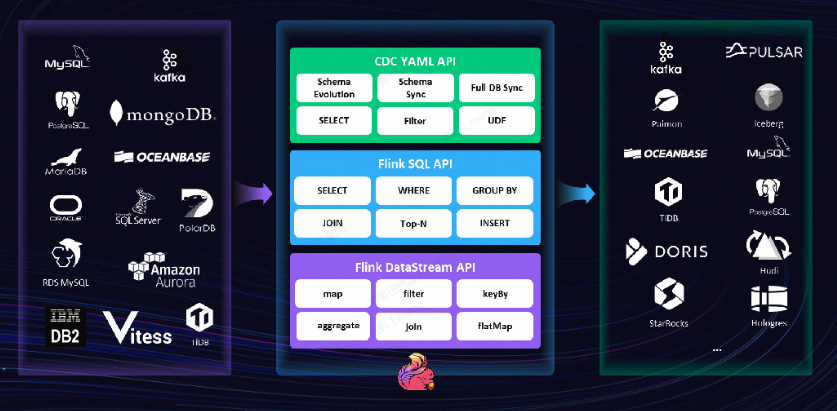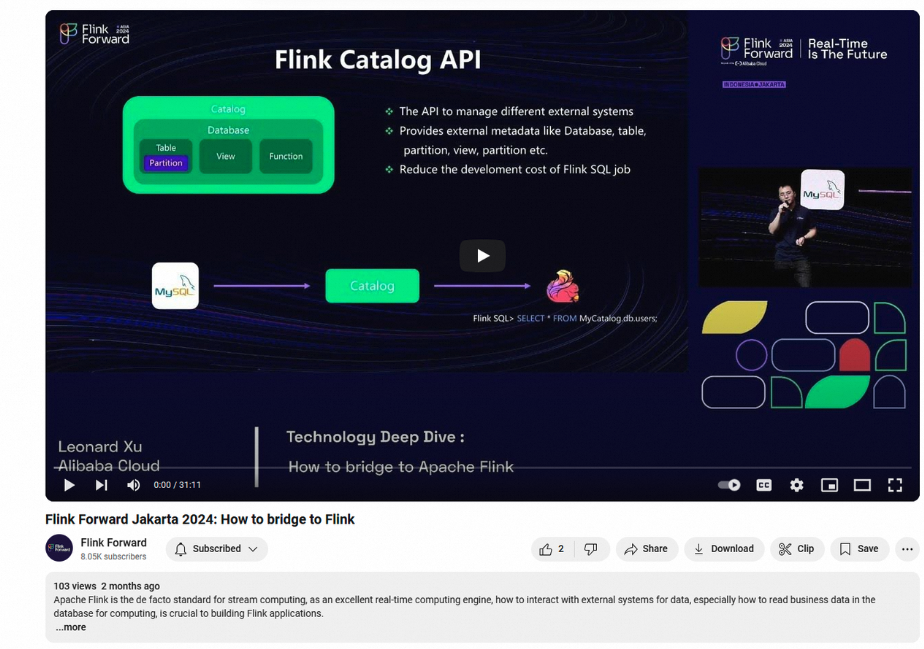
Flink CDC empowers you to manage real-time and batch data processing with ease. It acts as a distributed data integration tool, enabling you to capture and synchronize changes from multiple databases. This capability ensures your data pipelines remain up-to-date and reliable. With its unified approach to streaming and batch workloads, Flink simplifies your architecture while maintaining low latency and fault tolerance. Whether you need to handle large data volumes or perform complex stateful processing, Flink offers the scalability and flexibility required for modern data workflows.

youtube video: https://youtu.be/VUIGIhYyDn8?si=he1Q8EWW2y3bq0gi
Flink CDC is a distributed data integration tool designed to handle both real-time and batch data processing. It simplifies the creation of data pipelines by using YAML configurations, making it easier for you to describe how data moves and transforms. Unlike other tools, Flink CDC integrates seamlessly with Apache Flink, offering a unified platform for streaming and batch workloads. This approach ensures low latency and fault tolerance, making it a reliable choice for modern data workflows.
The primary goals of Flink CDC include enabling real-time change data capture, supporting multiple databases, and providing stateful processing capabilities. For example, it captures updates, inserts, and deletes from databases as they occur. This ensures your data pipelines remain synchronized and up-to-date. Additionally, Flink CDC scales effortlessly to handle large data volumes, making it suitable for distributed systems.
| Goal/Purpose | Description |
|---|---|
| Real-time change data capture | Captures updates, inserts, and deletes from databases as they happen. |
| Unified streaming and batch processing | Simplifies architecture by handling both workloads in a single application. |
| Support for multiple databases | Integrates with databases like MySQL, PostgreSQL, and MongoDB without custom connectors. |
| Low latency and fault tolerance | Processes data with minimal delay and ensures recovery during failures. |
| Stateful processing capabilities | Enables tasks like aggregations and data enrichment on change data. |
| Scalability | Handles large data volumes and scales to meet growing demands. |
Flink CDC captures changes in your database in real-time. It continuously monitors updates, inserts, and deletes, ensuring that your data pipelines reflect the latest state of your source systems. Acting as middleware, it connects your data sources to various sinks, such as cloud data warehouses or analytics platforms. This allows you to stream state data efficiently.
The tool supports both full and incremental data synchronization. Full synchronization ensures that all historical data is captured, while incremental synchronization captures only the changes. Flink CDC uses advanced mechanisms like an incremental snapshot algorithm to avoid database locking. This ensures operational integrity and prevents disruptions to your source systems.
By default, Flink CDC operates in streaming mode, providing sub-second latency for real-time synchronization. This makes it ideal for scenarios where fresh data is critical. Whether you need to update a local cache or synchronize an OLAP system with OLTP data, Flink CDC ensures consistency and reliability.
Flink CDC has been successfully implemented in various scenarios. You can use it for real-time data processing and analytics, where timely insights are crucial. It also supports microservices architectures through the outbox pattern, enabling seamless communication between services. For businesses relying on continuous queries, Flink CDC powers real-time analytics by keeping your data pipelines updated.
Other use cases include keeping OLAP systems synchronized with OLTP data, building data pipelines for cloud data warehouses, and updating local caches with fresh data. Flink CDC also supports full-text search data store synchronization, ensuring that your search systems always reflect the latest information. Its versatility makes it a valuable tool for modern data integration challenges.
Flink CDC enables you to build robust CDC pipelines that ensure real-time synchronization of your data. These pipelines capture changes from your source databases and deliver them to downstream systems with sub-second latency. This capability keeps your data fresh and ready for analysis or operational use. By operating in streaming mode, Flink CDC ensures that updates, inserts, and deletes are processed as they occur, maintaining consistency across your systems.
The tool supports heterogeneous data sources, allowing you to integrate data from platforms like MySQL, PostgreSQL, and MongoDB. This flexibility simplifies the creation of streaming ETL pipelines. Additionally, Flink CDC offers features like database and table splitting and merging, which enhance the flexibility of your data management and synchronization processes. These features make Flink CDC an ideal choice for real-time data integration.
| Feature Description | Benefit |
|---|---|
| Incremental snapshot reading algorithm | Enables lock-free reading and resumable uploads. |
| Friendly database entry design | Improves stability during data ingestion. |
| Support for heterogeneous data sources | Simplifies streaming ETL processes. |
| Database and table splitting and merging | Enhances flexibility in data synchronization. |
Flink CDC simplifies schema evolution and table creation during data integration. When a schema change occurs in your source database, Flink CDC automatically adapts to it. The SchemaRegistry introduced in Flink CDC 3.0 manages these changes seamlessly. The SchemaOperator temporarily pauses streaming ingestion to ensure consistency, then resumes it after synchronization. This process ensures that schema evolution is handled smoothly without disrupting your pipelines. Flink CDC also supports automatic table creation.
Flink CDC uses an incremental snapshot algorithm to ensure efficient and stable data synchronization. This algorithm divides tables into chunks for concurrent reading during the full reading phase. It then switches to a lock-free approach during the incremental phase. This design eliminates the need for global locks, which can disrupt online services. You can rely on this algorithm to perform lock-free reading, concurrent reading, and resumable uploads, even for large datasets.
This approach addresses common challenges in MySQL CDC, such as database locking, by maintaining operational integrity. The incremental snapshot algorithm ensures that your pipelines remain stable and efficient, even under heavy workloads. With this feature, Flink CDC provides a reliable solution for real-time data integration.
Tip: The incremental snapshot algorithm is particularly useful for maintaining high availability in production environments.
Flink CDC simplifies full database synchronization by enabling you to synchronize all tables from a source database to downstream systems in a single job. This feature ensures that your data pipelines remain consistent and up-to-date. Whether you are working with historical data or capturing real-time changes, Flink CDC provides a seamless way to manage your data integration needs.
The tool supports both full and incremental data synchronization. During full synchronization, it captures a real-time consistency snapshot of each table. This ensures that all existing data is accurately transferred to the target system. Incremental synchronization captures updates as they occur, appending new data and updating existing records without duplication or loss. This dual approach ensures that your pipelines handle both historical and real-time data efficiently.
Flink CDC guarantees exactly-once processing, even in the event of job failures. This means that every change captured from your source database is processed exactly once, ensuring data integrity and consistency. You can trust that your pipelines will deliver accurate and reliable data to downstream systems.
Key benefits of exactly-once processing include:
Flink CDC achieves these capabilities through its advanced connectors and robust architecture. The connectors allow you to integrate data from various sources, such as MySQL and PostgreSQL, while maintaining high performance. By combining full database synchronization with exactly-once processing, Flink CDC ensures that your pipelines remain stable, consistent, and ready for real-time applications.
Note: Flink CDC's exactly-once processing is particularly valuable for businesses that rely on accurate data for decision-making.
Flink CDC addresses common data integration challenges by enabling real-time change data capture. You can use it to synchronize data across systems, ensuring consistency and accuracy. This capability is essential for maintaining audit trails, where every change in your database is recorded and stored for future reference. Flink CDC also bridges the gap between traditional and streaming architectures, allowing you to integrate legacy systems with modern data workflows.
With Flink CDC, you can capture updates, inserts, and deletes as they happen. This real-time capability supports applications like fraud detection, where instant responses to suspicious behavior are critical. For example, you can flag unusual transactions and prevent fraud before it occurs. Additionally, Flink CDC triggers recomputations of analytics based on CDC stream events. Dashboards and reports always reflect the most current data, enabling better decision-making.
Tip: Use Flink CDC to ensure your data integration pipeline remains robust and responsive to changes in your source systems.
Flink CDC powers various real-world applications. For instance, you can maintain a database audit trail by streaming changes into Parquet files stored on AWS S3. This setup provides a complete history of database modifications. Another use case involves creating materialized views. Flink CDC captures database changes and updates a secondary database in real time, enhancing the performance of data-driven applications.
Real-time inventory management is another area where Flink CDC excels. You can process customer purchase events to update inventory levels instantly, ensuring accurate order processing. Flink CDC also supports multiple destinations. For example, you can stream database changes from SQL Server to Kafka, enabling parallel processing for audit trails and fraud detection.
Note: These use cases highlight the versatility of CDC pipelines in solving complex data integration challenges.
Flink CDC offers significant benefits for data engineers and organizations. Its real-time change data capture ensures continuous updates, making it ideal for real-time applications and analytics. By unifying streaming and batch processing, Flink simplifies your architecture and reduces operational complexity. You can integrate data from multiple databases without the need for custom connectors, saving time and effort.
Flink CDC provides low latency and fault tolerance, ensuring data consistency even during failures. Its stateful processing capabilities allow you to perform complex tasks like aggregations and data enrichment efficiently. The tool scales effortlessly to handle large data volumes, making it suitable for growing businesses. As an open-source solution, Flink CDC offers customization options to meet your specific needs.
Callout: With Flink CDC, you can build scalable, reliable, and efficient data integration pipelines that drive business success.
When implementing Flink CDC, you may encounter several challenges that require careful planning and management. Handling schema changes in your source database is one of the most common issues. If not managed properly, these changes can disrupt your pipelines or lead to data inconsistencies. Flink CDC offers tools to address schema evolution, but you still need to monitor and configure these processes effectively.
Operational overhead is another factor to consider. You must continuously monitor data ingestion rates and manage system resources to ensure smooth operation. This requires setting up robust monitoring tools and allocating sufficient resources to handle peak loads.
Finally, expertise in distributed systems and stream processing is essential. Flink CDC requires advanced technical knowledge, which means you may need a specialized engineering team for setup and maintenance. This expertise ensures that your pipelines remain efficient and reliable.
| Challenge | Description |
|---|---|
| Handling schema changes | Dealing with schema changes in the underlying database can break pipelines or result in data inconsistencies if not properly managed. |
| Operational overhead | Ongoing management and monitoring are required to ensure reliable operation, including monitoring data ingestion rates and managing resources. |
| Security and compliance | Protecting sensitive data requires implementing encryption, authentication, and access controls to comply with regulations like SOC 2 Type II and GDPR. |
| Expertise requirement | Advanced technical expertise in distributed systems and stream processing is necessary, often requiring specialized engineering teams for implementation and maintenance. |
Flink CDC excels in many use cases, but it may not suit every scenario. For example, if your data integration needs are limited to small, static datasets, a simpler ETL tool might be more appropriate. Flink CDC's advanced features are designed for dynamic, real-time environments, which may be unnecessary for static data workflows.
Additionally, if your organization lacks the technical expertise required for distributed systems, implementing Flink CDC could become challenging. The tool's complexity demands a solid understanding of stream processing and resource management.
Another consideration is cost. While Flink CDC is open-source, the infrastructure and resources needed to run it at scale can be significant. If your budget is limited, you might need to explore alternative solutions that require fewer resources.
Lastly, Flink CDC may not be ideal for scenarios where ultra-low latency is critical. Although it provides sub-second latency, certain specialized systems might offer even faster performance tailored to specific use cases. Evaluating your requirements carefully will help you determine if Flink CDC aligns with your goals.
Tip: Assess your organization's technical capabilities and data integration needs before choosing Flink CDC to ensure it fits your specific use case.
Flink CDC offers you a powerful solution for real-time data integration. Its features simplify your workflows and enhance efficiency. Key benefits include:
You can explore Flink CDC to unlock its potential for your data workflows. Its flexibility and reliability make it a valuable tool for modern data integration challenges.
Full synchronization captures all historical data from your source database. Incremental synchronization tracks and processes only the changes (inserts, updates, deletes) after the initial sync. This dual approach ensures both historical and real-time data are handled efficiently.
Yes, Flink CDC YAML-based configuration automatically adapts to schema changes. It updates downstream systems to reflect modifications in the source database. This feature ensures your pipelines remain consistent without requiring manual intervention.
Absolutely! Flink CDC offers YAML-based configurations, making it accessible for users without coding expertise. You can set up pipelines using simple configuration files and quick-start demos, which require only basic system knowledge.
Flink CDC supports popular databases like MySQL, PostgreSQL, MongoDB, and more. Its advanced connectors ensure seamless integration with these systems, enabling you to build robust pipelines for diverse data sources.
Flink CDC guarantees exactly-once processing. It ensures no data is lost or duplicated, even if a job fails. This reliability makes it a trusted choice for critical applications requiring accurate and consistent data.
Note: Exactly-once processing is crucial for maintaining data integrity in real-time workflows.
FLIP-1:How to handle task failure: Flink's intelligent recovery strategy
Apache Flink: Powering Real-Time Personalization in Retail and E-Commerce

166 posts | 46 followers
FollowApache Flink Community China - May 13, 2021
Apache Flink Community China - May 18, 2022
Apache Flink Community China - February 19, 2021
Alibaba Clouder - January 7, 2021
Apache Flink Community China - June 2, 2022
Apache Flink Community China - April 13, 2022

166 posts | 46 followers
Follow Resource Management
Resource Management
Organize and manage your resources in a hierarchical manner by using resource directories, folders, accounts, and resource groups.
Learn More ApsaraDB for MongoDB
ApsaraDB for MongoDB
A secure, reliable, and elastically scalable cloud database service for automatic monitoring, backup, and recovery by time point
Learn More AnalyticDB for PostgreSQL
AnalyticDB for PostgreSQL
An online MPP warehousing service based on the Greenplum Database open source program
Learn More Cloud Shell
Cloud Shell
A Web browser-based admin tool that allows you to use command line tools to manage Alibaba Cloud resources.
Learn MoreMore Posts by Apache Flink Community
Start building with 50+ products and up to 12 months usage for Elastic Compute Service
Get Started for Free Get Started for Free